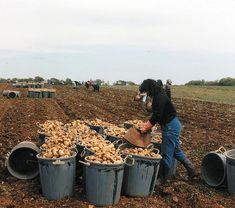

“THERE HAVE been no difficulties apart from a delay in lifting,” says Savas Papasavas, marketing officer at the Cyprus Potato Marketing Board (CPMB), reporting on the new season's potato crop. “We were expecting to lift in the beginning of March but couldn't start until last weekend. There has been continued rain and even snow which is unusual for Cyprus, so the crop has been three to four weeks late.”
Despite the erratic weather conditions, all reports indicate that the quality of produce remains unaffected. Ernst Geiser's managing director, Michael Ansell, confirms that growing conditions have now improved. “We've not had any frost damage,” he explains. “That's one thing we seem to have avoided. As long as that doesn't happen we'll be OK. But I think the moment for frosts has passed now.”
All indications point to a reasonable season but for Cypriot producers, used to sunnier conditions, rain-induced lifting disruption has become a depressingly familiar story. Especially since the recently finished winter crop fell short of expectations. Ansell explains: “The [winter] crop quality was good, but the quantity was less than expected because there was too much rain at lifting time.”
And the extent of the damage has only recently been confirmed. Nicos Genneos, export manager at CPMB, reveals: “Between 3,000 and 4,000 tonnes of this crop were left in the soil in the Nicosia area due to the heavy rain. But generally the exported quantity, 10,000t, was of good quality. Irrespective of the fact that in Cyprus the winter saw a lot of rain with snow on the mountains, the potato crop hasn't suffered from any severe frost damage up to now.”
Despite a tardy arrival, the first of the spring crop has reached the UK and volumes should fulfil expectations. “The spring crop looks very healthy,” Genneos continues. “Exports of this crop are expected to reach 70-75,000t overall, with 10,000 in March, 20,000 in April, 35,000t in May and 10,000t in June, although overall the spring crop total production is estimated at 20 per cent less than last season.”
When the Journal last reported on Cypriot potatoes, limited sendings had pushed prices to a premium ñ a situation that could well be repeated this year especially since plantings have been reduced. This year there will be an estimated 15-20,000t of potatoes destined for the UK market ñ a drop of around 5,000t on last year. “There has been a decrease in plantings,” Papasavas admits. “Last year was a disaster ñ there was no demand and so with instructions from the government some growers decided to plant less.
“Rising costs of production are another issue and then there is the scare with the Middle East. It hasn't affected us directly yet. But it is still too early to say. Oil prices could still go up.”
Certainly the current global situation has not helped matters. “We have been affected in some way,” Papasavas adds. “Because of the war some vessels may not be available. If you are willing to pay a higher price the vessels are there, but otherwise freight costs have definitely risen.”
Still, once the produce is on UK shelves, prices are expected to be at their best. Says Ansell: “We're looking forward to a good season. The price for old English ware crops is very low so there will be a certain amount of competition at the low end of the market. But this is a premium potato so people will pay for it regardless of what the English crop is doing. Come Easter people invariably want something new ñ we're looking forward to a buoyant season.”
Jim Parsons, director of distributors J&J Parsons (London)Ltd, agrees: “So far there have been sporadic loadings and we're running up to a month late, but we needed an early start this year. Prices are very depressed so we needed them in as early as possible to maintain an even supply and good price. But depending on the quantities that are shipped we would expect a strong demand with good prices.”
This shouldn't be a problem. Thanks to their unique characteristics Cypriot potatoes have an assured place in the UK market ñ and there are many that actively look forward to the first arrivals. “Cyprus potatoes have an absolutely excellent reputation,” Ansell says. “They are good multi-purpose potatoes with a very strong following. They are a premium product and they're highly sought after.”
Parsons agrees: “The Cyprus business has a very strong image ñ the market is crying out for them especially in the south ñ there's a big demand from the Turkish communities that insist on Cypriot potatoes.”
A strong varietal mix is one of the reasons for the guarenteed good reception. “Spunta and Diamant are the mainstays of the winter crop that come to the UK,” Ansell explains. “Spring varieties are Spunta, Nicola, Diamant and Cara. The latter is a late maturing variety which comes over in normal mixed sizes but they also do a large 65mm baker size in the later part of the season.”
Although Cypriot potatoes have been successfully exported to the UK for the last 70 years they are equally well known elsewhere. “In many countries they are respected as the best quality potatoes,” confirms Genneos. “Cyprus exports potatoes in approximately 20 countries, always taking into consideration the preferences in varieties, sizes and packing.
To satisfy the various preferences of the European consumers, Cyprus grows 15 varieties for export. The most important varieties grown for foreign markets are Spunta, Cara, Nicola and Diamant for the UK and Ireland, Nicola, Charlotte and Superstar for Belgium, Diamant and Liseta for Holland, Nicola, Filea, Marabel, Timate, Liseta and Marfona for Germany and Spunta for Greece, Italy and Croatia.” Genneos explains.
But the importance of developing new markets cannot be underestimated. “We are sure that Cypriot potatoes will soon be exported to some other ex East European countries like Russia, Poland, Hungary and Slovakia,” Genneos adds. “Although over the last few years UK supermarkets buy less Cypriot potatoes than in the past. But in other European countries our best clients are the big supermarkets.”
Increased competition from abroad has also put pressure on the industry as Ansell explains: “Cypriot potatoes are grown in red soil and that is largely what they are associated with. But other countries such as Italy and Spain have tried to copy this by growing on red soil as well.”
Although both countries have been successful to a degree by producing their crops on similar soils, Ansell believes that such produce has never managed to attain quite the same characteristics as Cypriot potatoes. If competitors were to be successful then the overall value of the variety would certainly drop.
Fortunately for Cypriot growers it takes more than coloured soil to make their potatoes unique. “They're very distinct,” Ansell explains. “They have a high dry matter and their own particular taste due to the rich soil. We always treat this as an umbrella crop. They might be a new crop but they are multi-purpose and can be used in other ways. Cypriot potatoes will always be the premium of that type of potato.”
According to Papasavas it is their cooking ability and the fact that they are lifted by hand that goes a long way to making them distinct. “From being picked, they go automatically to the warehouse ñ there are no storage facilities here ñ and that means that no chemicals are used after they are picked,” he explains.
In addition to competition from abroad there are other issues closer to home that growers are facing. And the main cause for concern over recent years has been the unpredictability of Cyprus's weather. Parsons explains: “If we look back 10 years or so the desalination plants were just being built. But thanks to the weather we've had over the past couple of years I'd say they were overflowing now.”
Ansell agrees: “In the past the pressure on growers has been the lack of water ñ but Mother Nature has been kind. The desalination plants that have been put up haven't been utilised as much as had been planned. This is a good thing, but of course nobody knows if this is a pattern that will continue.”
Still, as Genneos points out, reserves of water can never be a bad thing. “The lakes and dams on the mountains are full of good quality water which among other things will be used for the irrigation of spring potatoes,” he explains.
Despite the firm footing Cypriot potato varieties have established for themselves, work is well underway in the trialing of new varieties. Although as Papasavas explains much of the trialing is carried out with the European market in mind. “There is not really much experimenting that can be done for the UK,” he confesses. “Consumers tend to be very conservative. People are used to a certain thing and they don't like change. Besides, some of the other varieties aren't as well liked by the UK supermarkets.”
But the UK market appears more than happy with Cyprus's current offer, and a wide spread of European receivers absorbs any discrepancies in size. Says Ansell: “Abroad they prefer a smaller tuber than they do in the UK, so if the crop comes up with a higher element of small potatoes then they can grade out the sizes and work out what is too big to go to the UK.”
Perhaps the only area of concern for Cypriot potatoes then is the CPMB's warning of a drop in potato consumption across Europe. Genneos says: “Potato consumption is falling in most of the European countries although there are exceptions such as Greece. But this affects mostly European production and less the consumption of imported new potatoes. Decisions about the varieties and types of various products are nowadays taken rather by the supermarket buyers than the customers.”
However, Cypriot potatoes are well-established and certainly look to remain that way. Increased competition may be cause for concern, particularly with the production of red-soil potatoes, but as Ansell points out: “Imitation is the sincerest form of flattery,” and despite this, Cypriot potatoes have managed to remain unique. “There's only one thing that beats potatoes as a revenue earner,” says Papasavas, “and that's tourism.” Although, if the wet weather of recent months is anything to go by, that may not be the case for much longer.



